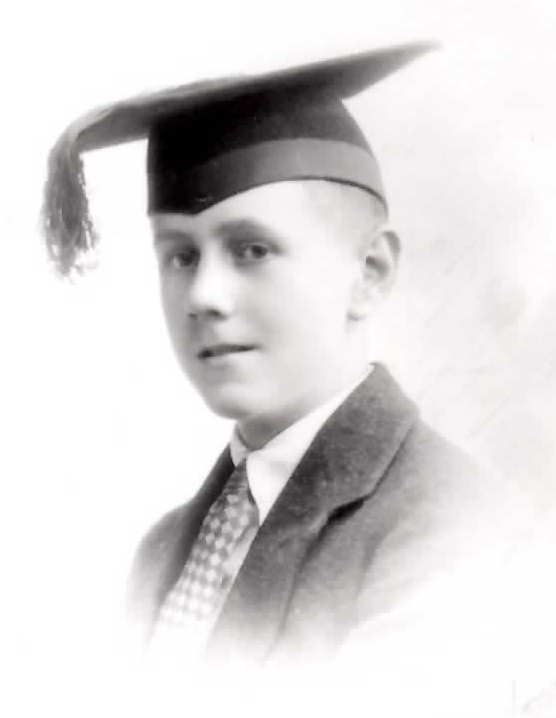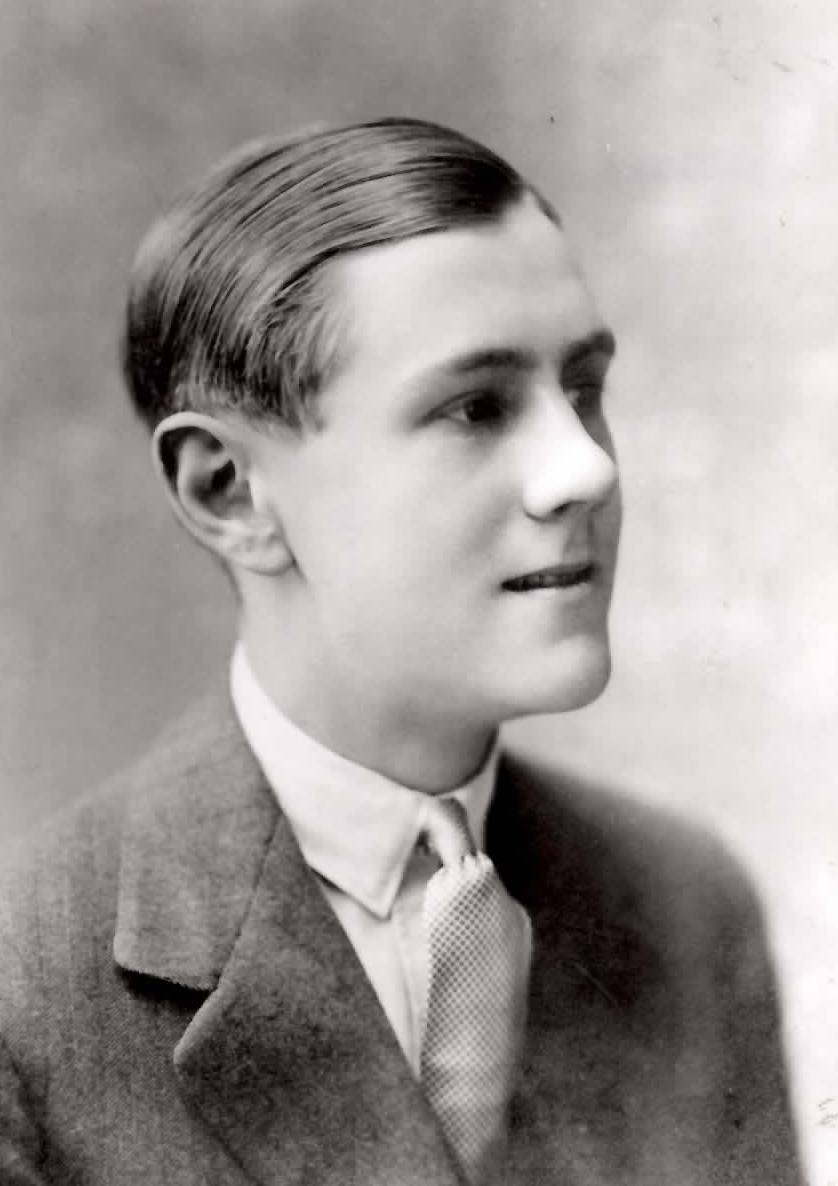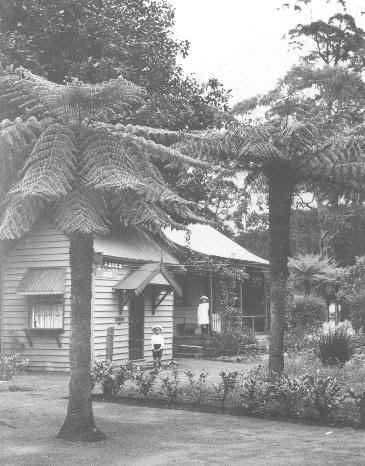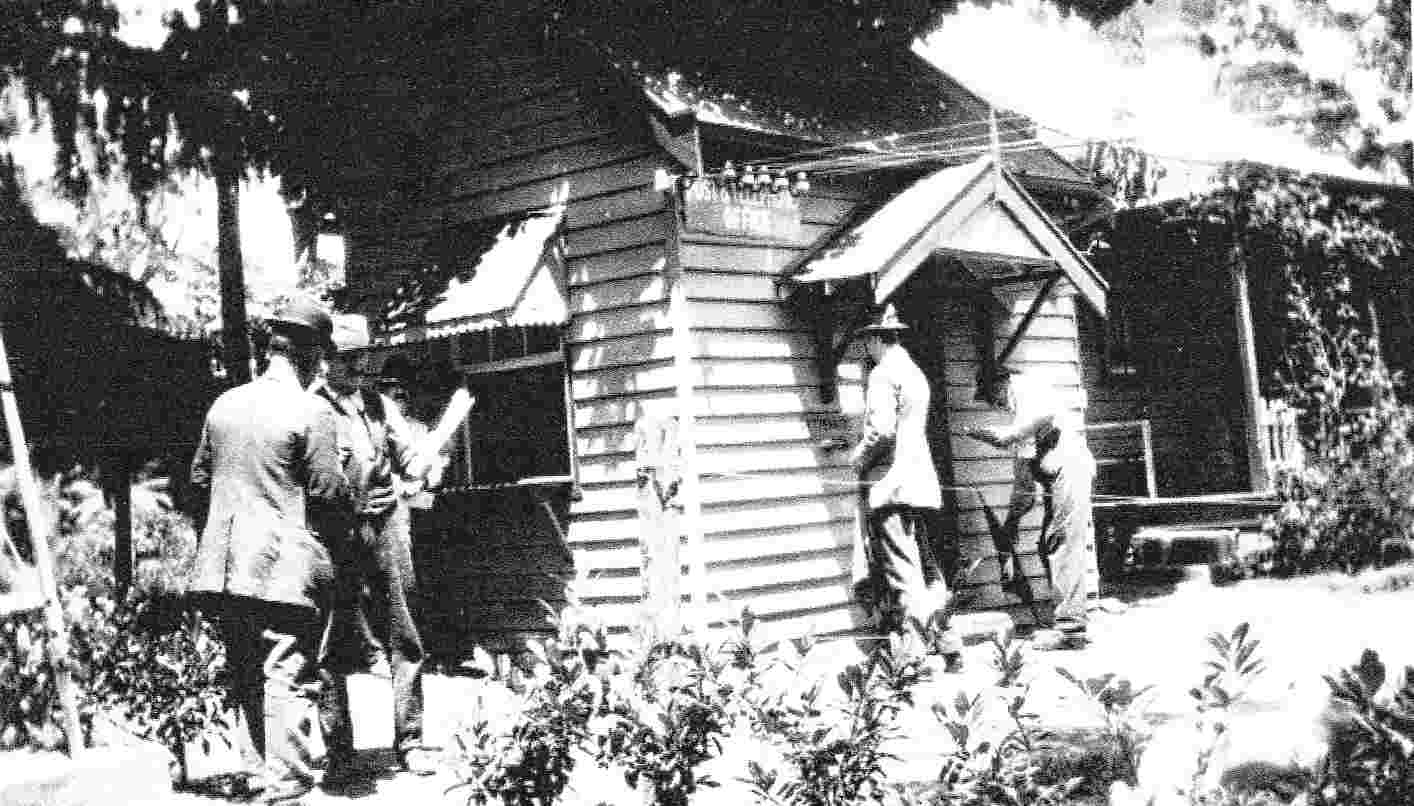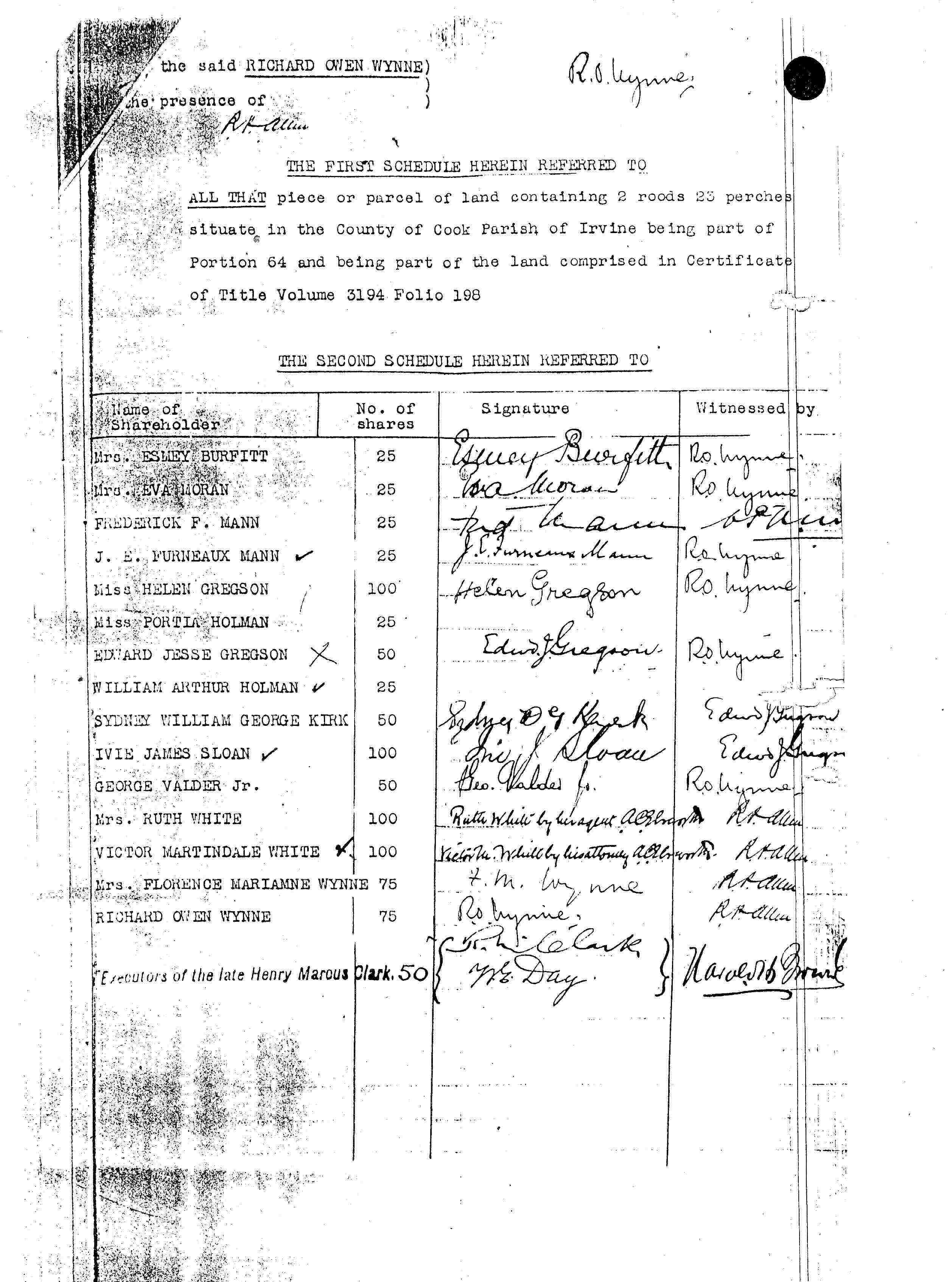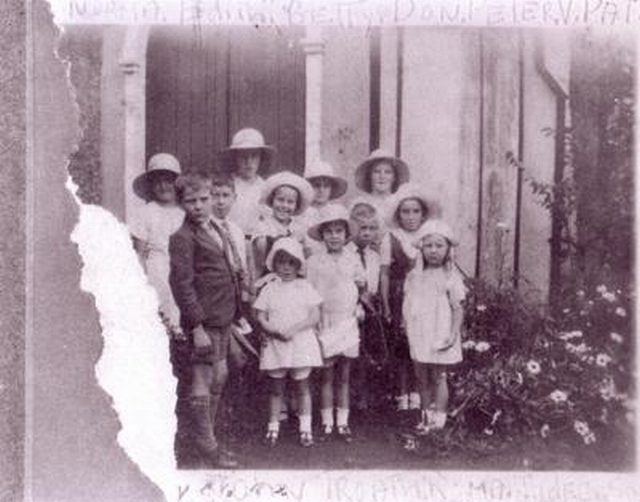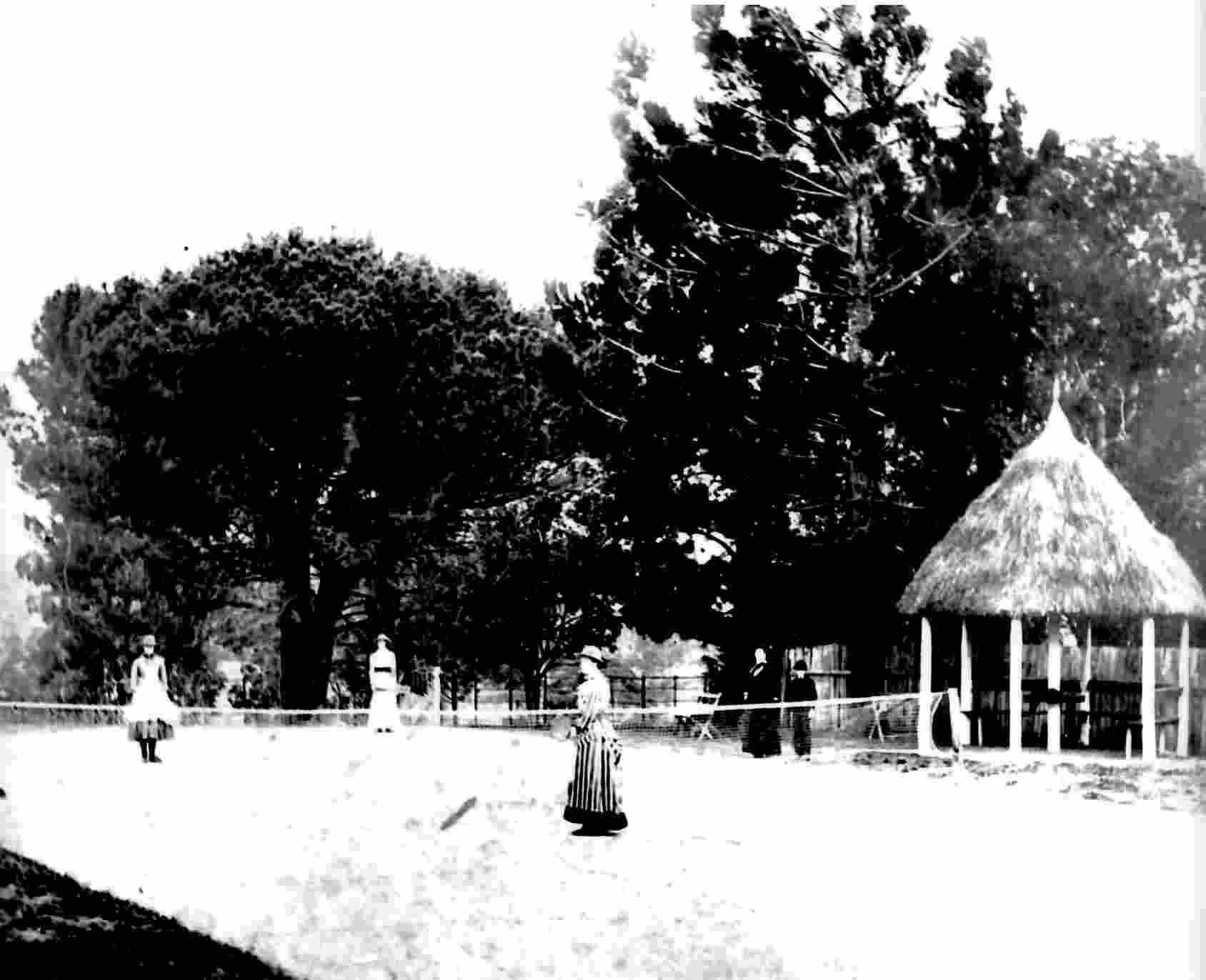Patrick White at Mt Wilson Exhibition
The Red Admiral – Patrick White at Mount Wilson
- Details
In 2012, the Mt Wilson and Mt Irvine Historical Society will celebrate the centenary of Patrick White’s 28 May 1912 birth date by holding a year-long exhibition at the Turkish Bath Museum at Mt Wilson.
Patrick White spent his formative years as a young child at Mt Wilson in the 1920s and 1930s; the exhibition will highlight the impact of both the Australian natural environment and the influence of working class and wealthy society individuals and families that were to strongly shape him for the remainder of his life, as an individual and as a writer of international acclaim.
The story of Patrick White and his family at Mt Wilson in the 1920s and 30s (the so-called 'Golden Age' of Hill Station life in Australia) is rich in historical interest, and yet, remains well hidden to most people.
The project aims to heighten awareness of the formative years of White's life in an easily accessible and understood manner. The exhibition has been specifically designed not to be an academic treatment of his literature, nor does it require an understanding or appreciation of White, or his works.
The goal is to foster a recognition of a vital influence on White that has previously been ignored, or misunderstood, for many years, despite the amount of research undertaken on the most famous and renowned Australian author.
The exhibition will be in the form of a series of framed A1 sized posters designed by a local professional graphics artist.
The title of the exhibition is taken from the name White used as a ten-year old. His first published pieces were about Mt. Wilson. The ‘Red Admiral’ was his favourite butterfly.
The exhibition was opened on 11.00am Sunday 17th June 2012 by the Governor of NSW, Professor Marie Bashir AC CVO at the Mt Wilson Village Hall.
The exhibition's posters and historical narrative can be viewed here.
The Red Admiral
- Details
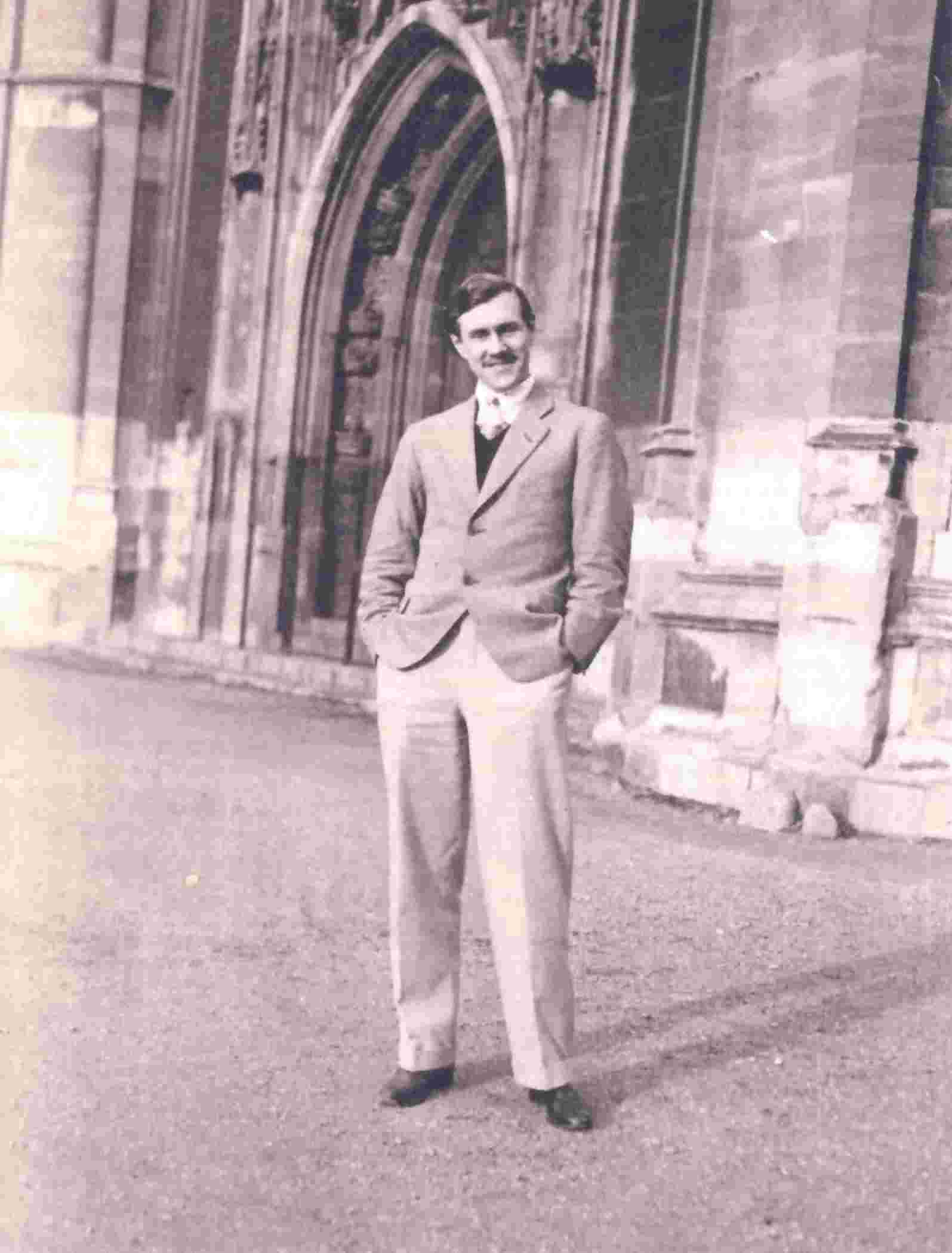
Patrick White at Cambridge circa 1932
Patrick White spent his formative years as a young child and adult at Mt Wilson in the 1920s and 1930s
[Mt Wilson] was the one place in Australia [I] dreamed of returning to one day
In 2012, the Mt Wilson and Mt Irvine Historical Society will celebrate the centenary of Patrick White's 28 May 1912 birth date by holding a year-long exhibition at the Turkish Bath Museum at Mt Wilson.
Patrick White spent his formative years as a young child at Mt Wilson in the 1920s and 1930s; the exhibition will highlight the impact of both the Australian natural environment and the influence of working class and wealthy society individuals and families that were to strongly shape him for the remainder of his life.
The story of Patrick White and his family at Mt Wilson in the 1920s and 30s (the so-called 'Golden Age' of Hill Station life in Australia) is rich in historical interest, and yet, remains well hidden to most people.
The project aims to heighten awareness of the formative years of White's life in an easily accessible and understood manner. The exhibition has been specifically designed not to be an academic treatment of his literature, nor does it require an understanding or appreciation of White, or his works.
The goal is to foster a recognition of a vital influence on White that has previously been ignored, or misunderstood, for many years, despite the amount of research undertaken on the most famous and renowned Australian author.
The title of the exhibition is taken from the name White used as a ten-year old. His first published pieces were about Mt. Wilson. The Red Admiral was his favourite butterfly.
The exhibition details the influence of Mt Wilson on Patrick White as an individual and a writer of international acclaim.
Additionally, a 25 minute film of White, and his relationship to Mt Wilson, has been produced and will be shown at the exhibition. The film features interviews with three Mt Wilson residents, Peter Valder, Mary Reynolds and Libby Raines, who all give a unique insight into White as a child.
Dr Bernadette Brennan and Dr Susan Lever, two respected academics from the University of Sydney and the Association for the Study of Australian Literature, and David Marr, White's biographer, are also interviewed in the film and explore Mt Wilson's influence on White's works.
In the film, the well-known Radio National journalist and producer, Rachael Kohn, conducts the interviews and White's first published pieces are read by Huw Evans. Both Rachael and Huw are long time residents of Mt Wilson.
A copy of the DVD can be requested by emailing This email address is being protected from spambots. You need JavaScript enabled to view it.
A donation to the Mt Wilson and Mt Irvine Historical Society to cover the costs of copying and mailing the DVD is suggested.
Patrick White: A Timeline
- Details
To this day, Patrick White remains Australia's only Nobel Prize winner in literature
1912 Born in London to Australian parents Victor (Dick) White and Ruth Withycombe. Raised in Sydney.
1921 First visit to Mt Wilson and the Wynne cousins. Dick and Ruth purchase Beowang (later Withycombe) for 2000 pounds.
1922 First published works - two letters to the Sydney Sunday Times.
1922-29 Educated at Cranbrook and Tudor House, NSW, and Cheltenham College, England.
1931 Worked on an unpublished novel (Finding Heaven) at Withycombe while waiting to go to Cambridge University.
1932-35 Attended Cambridge University, Kings College. Studied French and German languages and literature. Remained abroad for 13 years after graduation; travelled in Europe and America before the outbreak of war.
1937 Dick White dies.
1938 Withycombe sold to the Church of England for ten shillings.
1939 First novel Happy Valley published; awarded the Australian Literary Society (ALS) Gold Medal (1941).
1940-45 Worked as an intelligence officer in the Royal Air Force - Greece and Egypt.
1941 Publication of The Living and the Dead.
1948 Publication of The Aunt's Story. Returned to Australia and settled on a small farm, Dogwoods, at Castle Hill, Sydney.
1955 Publication of The Tree of Man; awarded ALS Gold Medal (1955).
1957 Publication of Voss; awarded the Miles Franklin Literary Award and, in 1959, the W.H.Smith Literary Award (UK).
1961 Publication of Riders in the Chariot.
1963 Ruth White dies.
1964 Publication of Night on Bald Mountain. Publication of The Burnt Ones; awarded ALS Gold Medal (1965). Moved to Centennial Park, Sydney.
1965 Publication of Four Plays.
1966 Publication of The Solid Mandala.
1969 Suzanne White dies.
1970 Publication of The Vivisector.
1973 Awarded the Nobel Prize for Literature for "his epic and psychological narrative art which has introduced a new continent into literature". Established the Patrick White Literary Award with money from the Prize. Publication of The Eye of the Storm. Named Australian of the Year.
1974 Publication of The Cockatoos.
1975 Awarded the Companion of the Order of Australia.
1976 Returned his Order of Australia in protest at the sacking of the Prime Minister Gough Whitlam in November 1975.
1978 Publication of The Night the Prowler.
1979 Publication of The Twyborn Affair.
1981 Publication of Flaws in the Glass.
1986 Publication of Memoirs of Many in One.
1990 Patrick White dies in Sydney.
2003 Manoly Lascaris, Patrick White's partner for nearly fifty years, dies.
Patrick White contributed generously to a multitude of causes including Aboriginal education, homeless men in Sydney, and the Red Cross. He donated numerous paintings to the Art Gallery of New South Wales.
His literary works have been translated into twenty eight languages.
Wynnes, Whites and Withycombes
- Details

Three influential families, linked by marriage and social influence, had a profound impact on the development of Mount Wilson
The earliest images of Patrick White in Mt Wilson are to be found in an album belonging to Jane Smart (nee Wynne, 1923-1995). Jane and her husband Bill Smart were the owners of Wynstay at Mt Wilson until 1999. Wynstay, originally known as Yarrawa, belonged to Jane's great-grandfather Richard Wynne. Jane's father, Richard Owen Wynne, renamed the property Wynstay, when he and his wife, Mariamne, completed the present neo-Georgian colonial residence in 1923.
Henry John Wynne and Marian Cecile White married in 1891. Their two children, Richard Owen and Dulcie Marion, were cousins to Patrick White.
Henry John was born in 1859. Henry was a bright lad at school and an excellent horseman. He attended the Royal Agricultural College (Cirencester, England) winning prizes in Veterinary Science and Estate Management in 1880; he was a founding member of the Sydney Lancers.
Marian Cecile, born in 1865 at Bando Station, on the Liverpool Plains, was the daughter of Henry Charles White of Havilah, Mudgee, and Isabella Mary Lowe. Henry Charles was Victor White's uncle, and brother of James White who founded and created the White wealth through property and pastoral activities at Belltrees in the Hunter Valley.
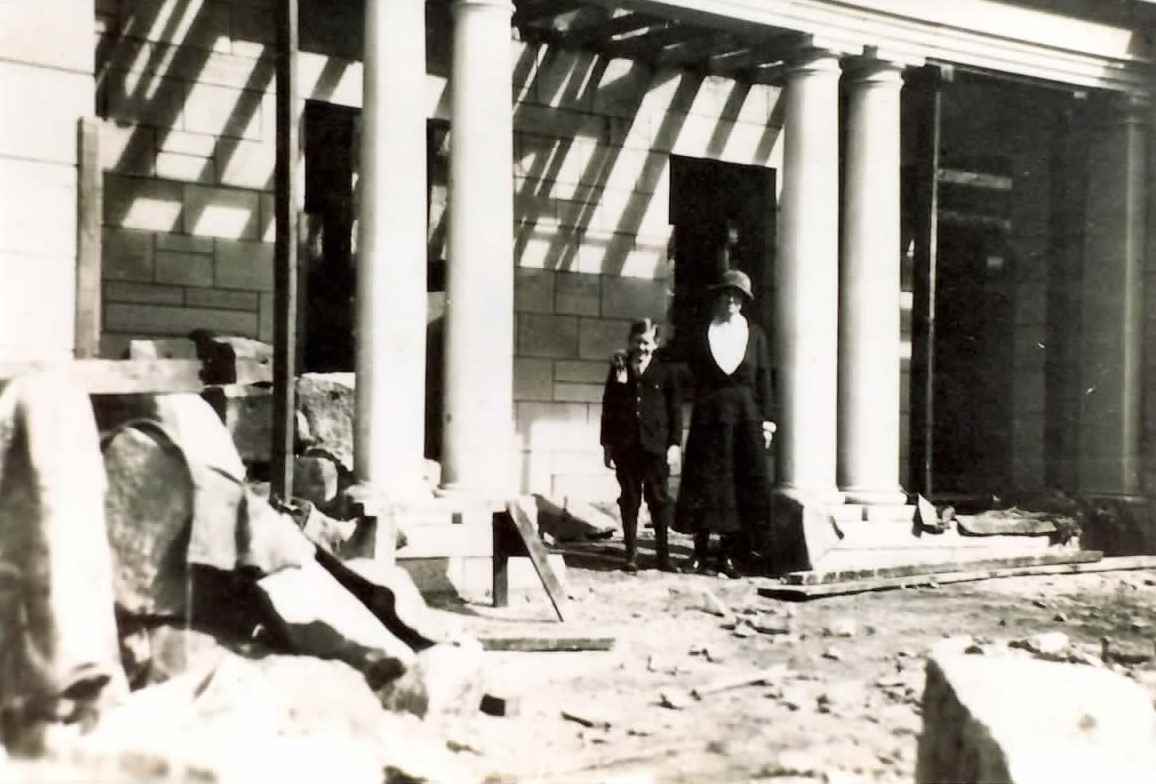
Patrick White's parents were distant cousins. In the Hunter Valley the Whites and Withycombes were neighbours. Ruth Withycombe's father, James, came to Australia in 1856, but died in England in 1899. Her mother, Winifred, was born into a prosperous family from the Hunter Valley in New South Wales. In 1910, Victor (Dick) White and Ruth married at St Philip's Church in Sydney.
In the social class system of the 1880s in NSW, the White family would have been seen as local aristocrats, being pastoralists and successful graziers. Richard Wynne, then owner of many acres in Mt Wilson - a recognised Hill Station - and a successful businessman, would likewise have been considered a member of the upper classes.Richard Owen inherited Yarrawa from his grandfather. He returned from England to live there after distinguishing himself as a Lieutenant Colonel DSO with the British army in World War I.
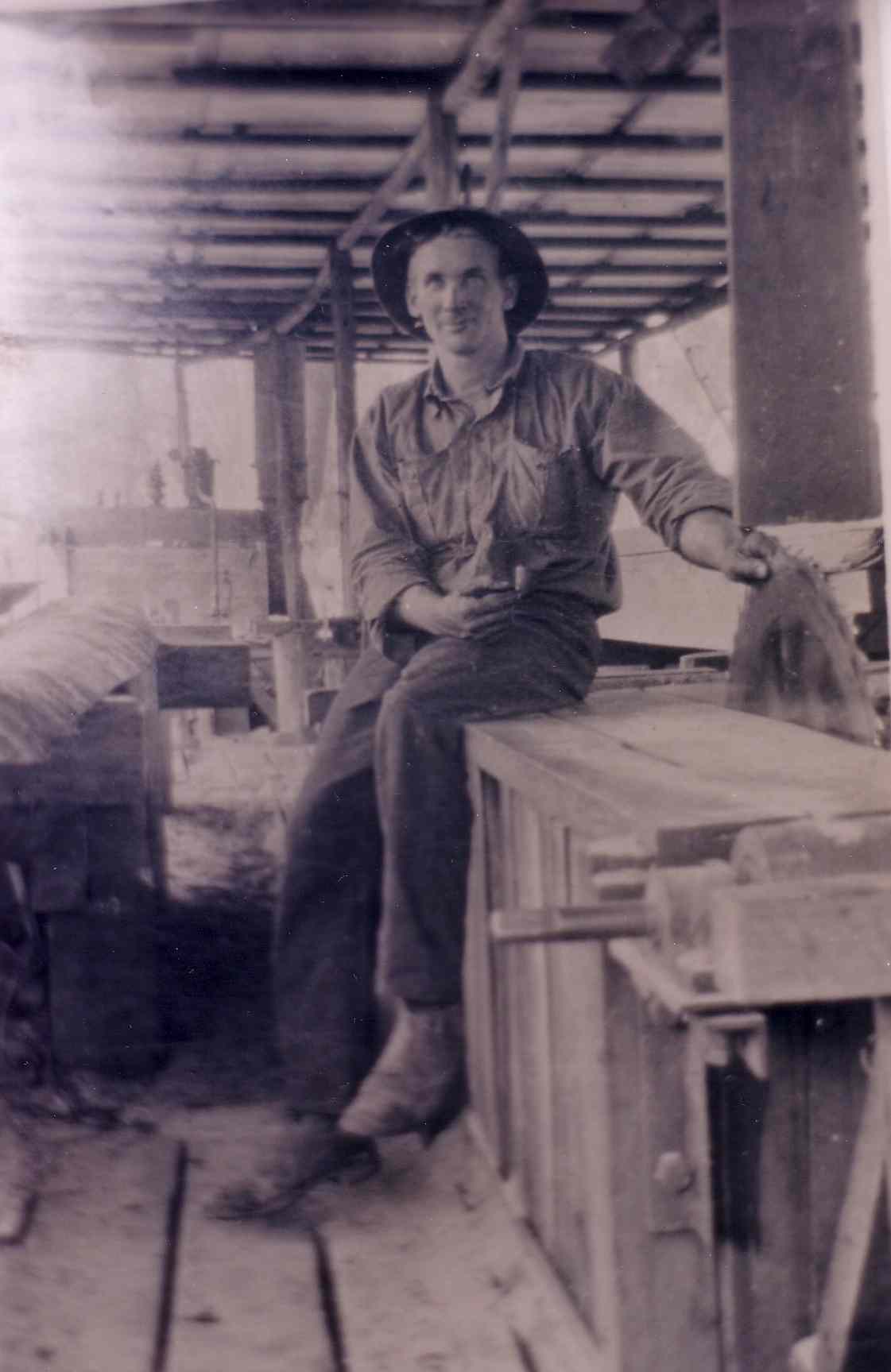
Syd Kirk at the Kirk's sawmill.
But there were other Mt Wilson residents, who were not rich and privileged, who formed strong relationships with Patrick White. Matt Davies had served as Colonel Wynne's batman during the War. His wife Flo had served in a number of wealthy homes in England, such as Blenheim Palace. The young Patrick loved staying with the Davies at Wynstay, writing that it was for him the "real world" and that Mt Wilson was "a paradise of my childhood".
His visits to Mt Wilson became more frequent when his parents purchased Beowang in December 1921.
Significantly, White's attachment to Mt Wilson strengthened deeply when his beloved Nanny, Lizzie Clark, married Sydney Kirk, a saw miller and the eldest of the seven Kirk brothers, all born and bred in Mt Wilson. Syd introduced Patrick to the magic, mystery, beauty and wonder of Mt Wilson. In Flaws in the Glass White writes: "Syd Kirk showed me lyrebirds, the wombat tracks, zircons in the trickle of the creek. He taught me to unravel bush silence".
Until Lizzie Clark's death in 1975, Patrick White and his partner Manoly Lascaris returned regularly to Mt Wilson to visit Lizzie and Syd Kirk, and Matt and Flo Davies, the people whom he loved and admired throughout his life.
A Place for Family
- Details
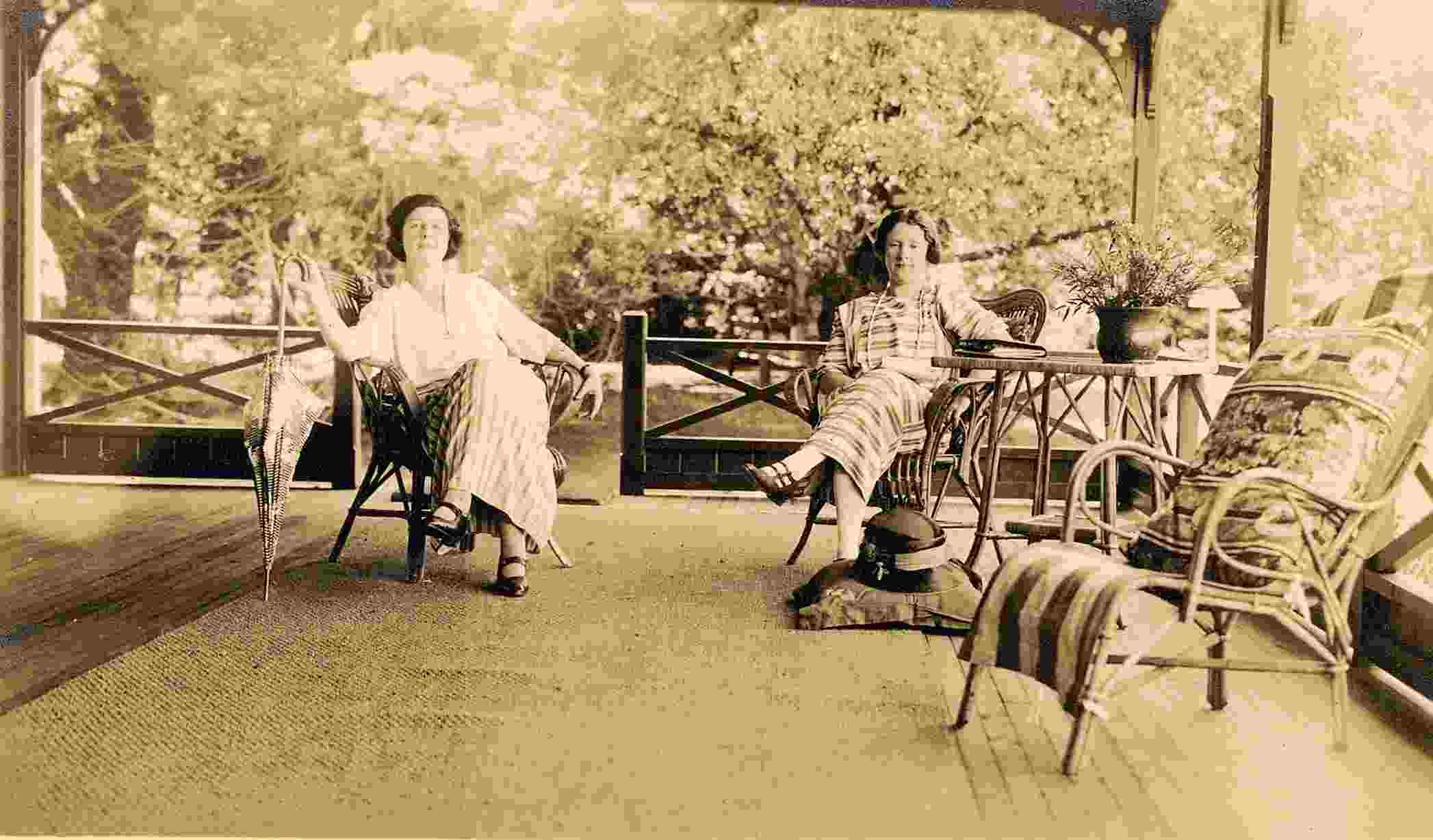
Mt Wilson in the 1920s and 1930s
Even in this remote part of the world, World War I acted as a catalyst for social change. By the end of the War, the original property owners from 1878-1880 had either sold or had passed on. Of those who had inherited land, three at least made the decision to become permanent residents and attempted to extract a living from the rich basalt soil and moist, cool climate. Some residents continued the pattern of arriving in November, and departing the following April. Guest houses became an attractive alternative for visitors as the attractions of Mt Wilson became more widely known.
For the first time, these resident owners, having survived the slaughter of World War 1, married and raised their children in Mt Wilson. One of those children, Helen Warliker (nee Gregson), captures some of the magic of those times in A Mount Wilson Childhood (1990). In the Foreword she writes: "Life was not idyllic but I think we were privileged to have been brought up in this unique environment, not only because of the beauty of its gardens and seemingly endless expanses of bushland which were our playground, but because of the diversity of people who formed the community".
In his eulogy for Jane Smart in St Georges Church, Mt Wilson, on the 17th June 1995, Peter Valder expressed a similar view: "it seems to me we were lucky to grow up in a magical innocent time in what I feel was the district's Golden Age". He continued: "The roads were not sealed, there was no electricity, no television, most of us did not have radios or cars, so community life flourished. I was especially fortunate that as a pre-school child the Wynnes allowed me, along with the Gregsons, to be taken under the wing of their own remarkable tutor Dorothy Moore or Dollie. We all learned to read andwrite, we sang, we played games, we painted, we made pottery (with Fred Mann), we did leatherwork, we wove things and we took part in small plays".

Mt Wilson School had an erratic existence due to fluctuating enrolment numbers. In the 1930s, however, the school opened regularly thereby introducing another stable element to the community along with the Parents and Citizens Association.
Surrounded as Mt Wilson is by bushland, the children of the 20s and 30s had the endless delights of bush picnics often led by Edward Jesse Gregson, Helen's father and a fine amateur botanist. As Helen describes them: "the billy was boiled and some times chops grilled. Then there were the Bogey Holes, a series of dark waterholes overshadowed by rocks - there surely must be a bunyip".
The children also gathered at Windyridge with Miss Helen Gregson, Edward's sister. Here a children's playground was created including the Maypole, the Giant's Stride, monkey bars and a seesaw. Lemon syrup and biscuits were offered as refreshments. Miss Gregson was a great believer in developing a sense of adventure in children.
Another unusual member of the community was Fred Mann who owned Yengo, which he named Stone Lodge. In Cherry Cottage at Stone Lodge he created pottery from the local clays and taught the children skills. On other occasions he generously hosted children's parties. As the children grew there were the joys of riding ponies, racing each other and jumping over logs, and the fun of New Year's Day Sports, initiated by the Country Women's Association.
Meanwhile, fetes and garden parties were a feature of life, especially at Wynstay. Mt Wilson's magnificent gardens were opened to the public to raise funds for projects such as the Village Hall. Suzanne White, Patrick's sister, was a generous contributor to this project.
Arrival and Departure
- Details
Why did the Whites come to Mount Wilson and why did they leave?
The White family owned Withycombe from 1921 until 1938. Throughout that time Patrick White and his family moved back and forth between Mt Wilson and Lulworth, the family home near Rushcutters Bay in Sydney.
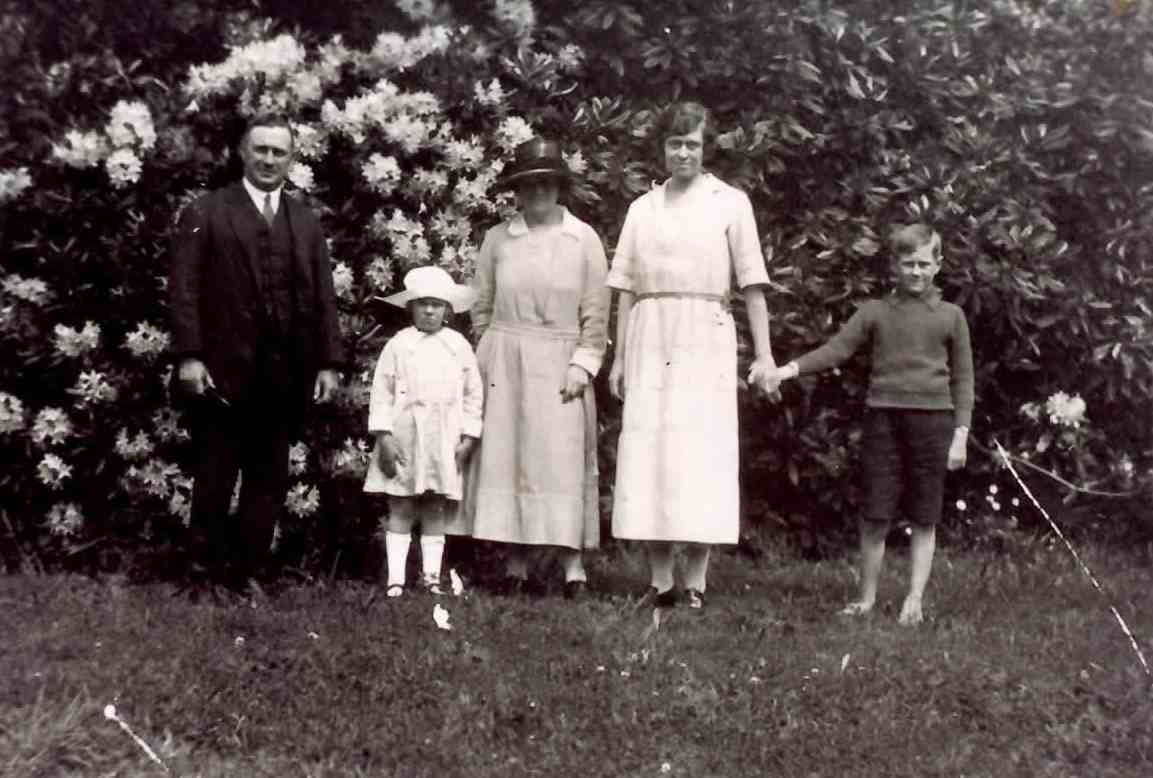
White came to Mt Wilson during his Australian school holidays. He attended Cranbrook in Sydney's Bellevue Hill (1920- 1922), Tudor House, Moss Vale, in New South Wales (1922-1924) and Cheltenham, a secondary school in England (1925- 1929). Eventually, he went to Cambridge University (Kings College,1932-1935) where he studied French and German languages and literature.
The purchase and settlement of the Mt Wilson house for 2000 pounds was finalised in 1921 and the Whites arrived in December. The Whites were financially secure and were thus able to buy a residence on this "hill station" where they, as did other wealthy families, would escape Sydney's summer heat and humidity. They came too for the supposed relief that the mountain air provided for ailments such as asthma, from which Patrick suffered all his life.
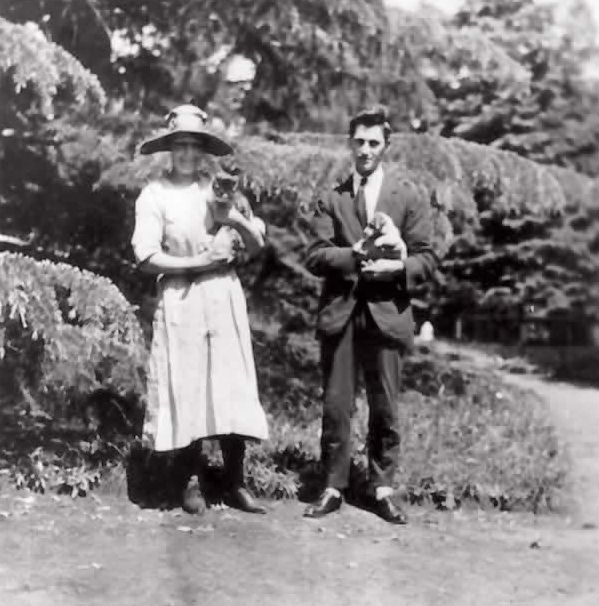
In his autobiography, Flaws in the Glass, White recalls how in 1921 he fought with his sister and on one heated occasion, when she tore up his books, he "half-throttled" her leaving a swollen throat, which was quickly diagnosed as mumps. For his own safety the asthmatic Patrick was sent to stay with the Wynnes at Mt Wilson. As Richard and Mariamne were committed to visiting relatives in the Riverina, Patrick was left in the care of Matt and Flo Davies, their devoted English servants.
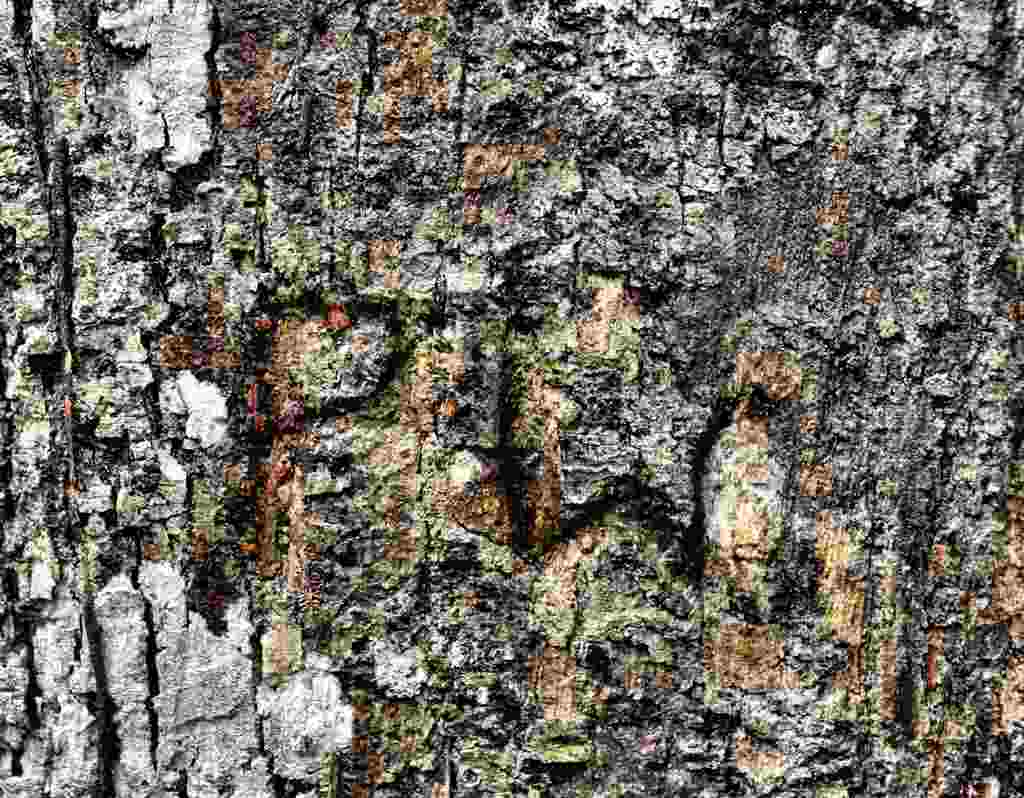
The White's house, originally called Beowang, was built by George Henry Cox, a wealthy pastoralist and sheepbreeder, in 1880, a short distance along the Avenue from Wynstay. Ruth White changed the house's name to Withycombe, her maiden name, because she disliked the name Beowang, an Aboriginal word referring to the local tree ferns. The garden Ruth cultivated in those early years, as with other early garden developments in Mt Wilson, used many exotic plants to create the look and feel of an English village. This included the removal of many tree ferns.
After graduating from Cambridge in 1935, White and his sister Suzanne travelled through Central Europe, but soon returned to London where Patrick was determined to make his mark as a playwright and novelist. Dick, Ruth and Suzanne returned to Australia in the northern autumn of 1935.
Dick White died in December 1937. In 1938 Ruth sold Withycombe to the Church of England (Sydney) for ten shillings. Archibishop Howard West Kilvinton Mowll and his wife were regular summer visitors to Withycombe and Woodstock. The London-based Patrick was unhappy with his mother's decision because he was keen to return to the Mt Wilson home at some stage. After the sale of Withycombe, Ruth White left Mt Wilson never to return, thus ending the White family's seventeen years in the mountain village.
The Whites in Mt Wilson
- Details
The White's contribution to the growth of the small community of MountWilson
It is difficult to assess the participation of the White family in the small Mt Wilson community between 1921 and 1938. Documentation during those years is fragmented when it comes to records of official community activity. However, we know that Patrick and Suzanne spent holidays enjoying the company of Matt and Flo Davies at Wynstay, Lizzie Clark, their Nanny, and Syd Kirk and other Kirk brothers. There must have been, especially in the 1920s, not only contact with the Wynne family but other recognised families in the community such as George Valder of Nooroo, Ivie Sloan of Bebeah,and the Manns of Dennarque.
Housed within the grounds of Withycombe was a small timber building which had operated as the Post Office since 1890, and the Telephone Exchange, since 1916. It is not surprising that this arrangement would have had little appeal for Ruth White as people ventured in and out of the grounds of Withycombe to conduct their postal and other business.
Ruth and Dick White, along with fifteen other families who lived in Mt Wilson in the 1920s, as well as the executors of the estate of Henry Marcus Clark, set up a private company to establish a local Post Office, store and residence in the Avenue, close to, but away from Withycombe.
A Trust Deed was set up for this purpose. Ruth and Dick purchased a maximum of 100 shares each at 1 pound per share. However, the legal formalities were not finalised until 1925.
The Post Office was designed by John Moore, a leading Sydney architect, on land donated by Richard Owen Wynne. It functioned from 1922 until December 1986, when postal facilities ceased in Mt Wilson. Since 1987 the Post Office building has been a cafe and private residence.
The Whites would have been participants in the social fabric of Mt Wilson, especially those activities organised by Mariamne Wynne, such as the tennis parties, bridge gatherings and dances. The relationship with St Georges Church may have been rather more fractious - Ruth despised the Mt Wilson church for aesthetic reasons: "I'd burn it down if it would burn", said White of his mother's view of the Church in Flaws in the Glass.
In the mid 1930s, Suzanne White joined a committee formed by Mariamne Wynne to take up the cause of constructing a Village Hall for Mt Wilson. Listed as Suzanne White of Withycombe, she remained supportive until the Hall was built in 1950-51, long after Ruth had sold Withycombe and left Mt Wilson. A curious twist in the story of the Hall is the donation of 100 pounds by Archbishop Mowll in 1941 to the Hall funds. According to Isa Valder that money came from the sale of Withycombe by the Archbishop.
First Writings
- Details
White's first published works were written about Mount Wilson
Patrick White's first published work consists of two letters published in the Sydney Sunday Times newspaper.
The Comic and Children's Pages had a section called The League of Friendship, edited by the President. It was made up of a short note from the President, notices and a list of prizewinners for the best letters. The largest part was devoted to The Mail Bag where letters from children were published under a pseudonym, and the President added a brief comment in reply.
On January 29 1922, and on October 22 1922, Red Admiral, the pen name of Patrick White, had letters published. Both letters comment on the young boy's time at Mt Wilson.
Patrick White was not quite 10 years old when the first letter was published. It describes the journey from the train station at Bell to the Mountain and his cousin's garden. Red Admiral is interested in the English trees and shows acute observation of people and places.
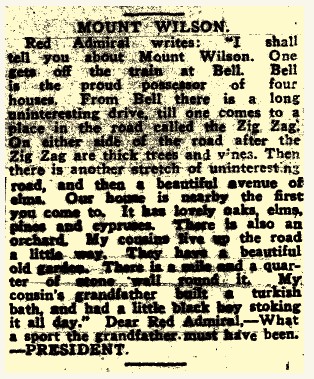
Sunday Times, January 29 1922
The second letter describes a moonlight picnic. The language here is rather more self conscious with a detailed descriptionof the waterfall and bush in moonlight, and Red Admiral also includes his own feelings about this expedition.
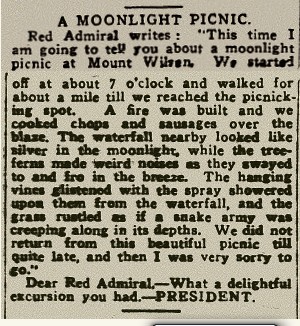
Sunday Times October 22 1922
We do not know why Patrick White chose the pen name of Red Admiral. The garden at Mt Wilson would have been full of flowers and butterflies; but, curiously, the Red Admiral butterfly is not found in Australia so perhaps it was a common colloquial name for a similar species. The young boy may have read about such butterflies in an English book and was captured by their beautiful patterns and colours; perhaps he just liked the sound of it.
These were not the first letters that Patrick White wrote - he had already written thank you letters, as well as ones to Father Xmas and Dear Fairie - but they were his first published letters.
Dreaming of Mt Wilson
- Details
When he was thirteen, White's parents sent him to England so that he could finish his secondary schooling.
He did not like it there and he wrote a number of poems that were privately published through the effort of his mother. One of those poems has references to Mt Wilson
In September 1925, Patrick White was taken by his parents to Cheltenham College, in Gloucestershire,England.
He did not enjoy his time at this exclusive boarding school. In his Flaws in the Glass: A Self Portrait, he remarked: "Ruth said while we were driving down to Cheltenham, 'This is the proudest day of my life'. When the gates of my expensive prison closed I lost confidence in my mother, and the Uncle James [Patrick White's great uncle] in me never forgave. What my father thought I can't be sure. An amiable, accommodating husband, he went along with what she wanted".
The quality of his school work declined; he felt trapped and was very lonely, except when he would take himself to London with Ronald Waterall, a fellow student, to go to the pictures or theatre. White was to find some solace too during these times when he visited his favourite Cheltenham bookshop - and when he was writing his early poems.
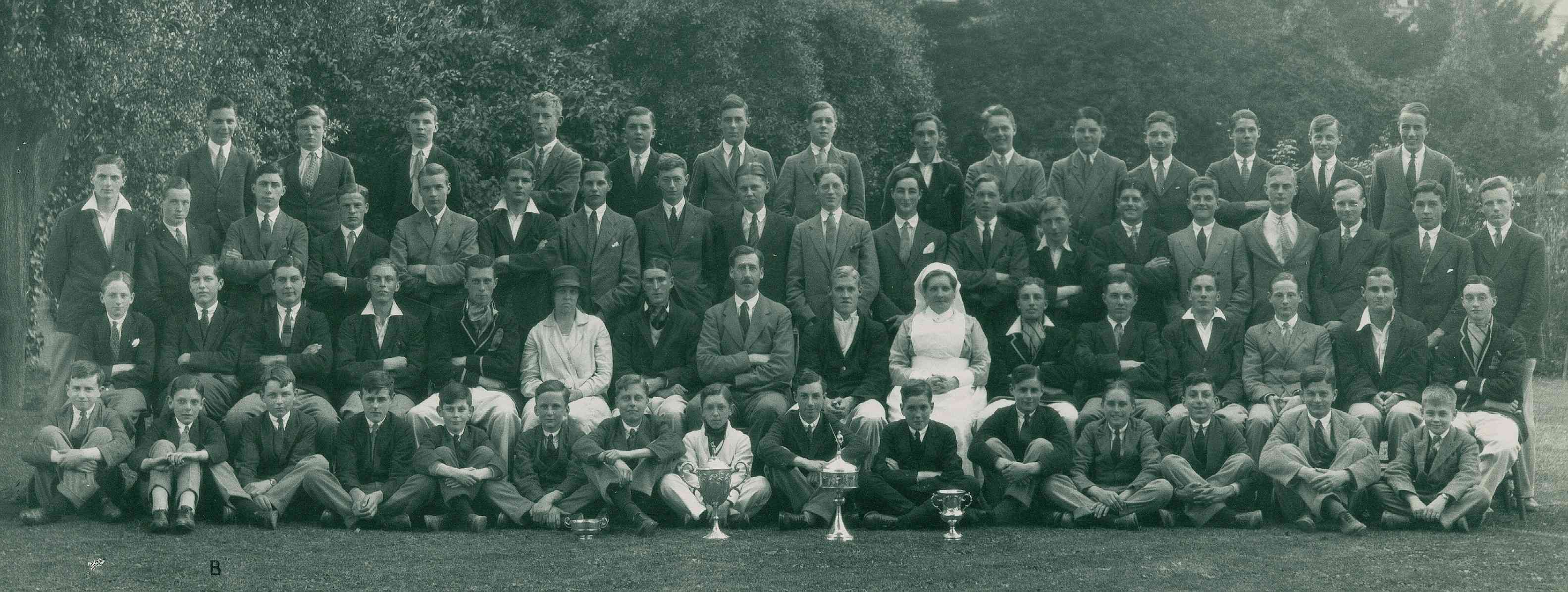
Southwood House, Cheltenham, photo of 1927. Patrick is in the back row, seventh from the left.
White sent his poems back to Australia where his proud mother had them printed. The volume, entitled Thirteen Poems, was published in 1930 and is now so rare that it is thought that only two copies survive, one of which is held in the Rare Books library at the University of Sydney.
White destroyed every copy that he could lay his hands on and he placed very strict conditions on its use while he was alive. These 13 poems were written between 1927 and 1929.
Two poems in the volume A Rustic Eclogue (1927) and The Death of Arabella Cheyne(1928) were dedicated to Ruth, his mother: "Dedicated to Mummy, Christmas, 1927" and "To Mrs Victor White, with the author's compliments", respectively. The formality of the second dedication is perhaps an indication of White's anger at his mother, especially for putting him in the school on the other side of the globe.
There is one poem in the volume which has a special link to Mt Wilson.
Long Ago: A Reminiscence
I think that it must have happened in a dream,
So far removed, so distant does it seem,
A dream which somehow buried in my heart
At times creeps forth to soothe my troubled soul
And all its buried fragrancy impart,
The fragrance of fresh lilacs in a bowl,
Fresh picked and on each clust'ring bloom the dew
As glistening as when from the skies it flew.
Flung from the purpled train of murky night;
And so once more this vision brings to light
The days when I was still a little boy,
When life was but a game from morn till night,
When Sue and I disputed for some toy
And Nurse was forced to come and stop the fight.
Our morning walks come back so vividly
When I refused to act constrainedly,
But must rush on ahead and, falling, skin
My knees, or Sue must bash her sturdy shin;
And there were picnics near the waterfall
Where tadpoles swam about in pebbled pools,
Just meant for every childish hand to maul
And gaily cram in jars, where, as a rule,
They only live to die in muddy dregs.
The picnics done, we ran on hastening legs
Down to the saw-mill in the sassafras.
How loved we then to watch the steely mass
Of that giant moon, eating the fallen logs
With gaping teeth, while sawdust fell in showers,
Commingling with the oily stench of cogs
And toiling wheels, the scent of forest flowers
Floating upon the limpid summer air.
Christmas was never then a cold affair
Of frosts, and snow and frozen finger tips.
About our Christmas tree, with hops and skips
We flew, and made the gutt'ring candles dance,
Till, tired of this we ranged the garden o'er
And caught the frisking fireflies, if perchance
Unwary they became; but when we saw
Nurse sweeping down to pack us off to bed
No hour from out the twenty-four so dread
We climbed up high into a sycamore,
With not a thought for all the clothes we tore,
And there sat cowering close, against the stars
With bated breath. My heart beats strangely
When
I think of these far-off elusive hours
And strive to scape this toiling world of men
So fettered that they scarce know where to turn
And seek the liberty for what they yearn.
In A Moonlight Picnic, published when he was ten years old, White describes a moonlight picnic at the waterfall in Mt Wilson. Now look at the third and fourth stanzas. There are references to "picnics near the waterfall", "pebbled pools" and after the picnic White and his sister run to Sid Kirk's sawmill "in the sassafras" where they watch the "steely mass of the giant moon", the large circular saw-blade "eating the fallen logs with gaping teeth, while sawdust fell in showers". There was, too, "the oily stench of cogs and toiling wheels", contrasted with nearby "the scent of forest flowers floating upon the limpid summer air".
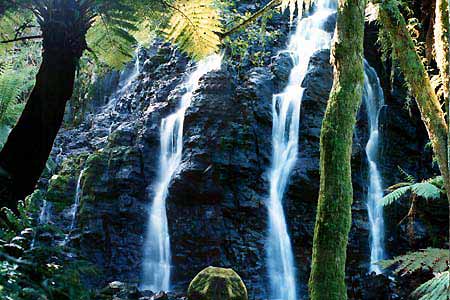
The Mt Wilson Waterfall
The poem is filled with the nostalgia of a teenage boy for long ago when he was a child: it also suggests that time and space are intertwined, as Mt Wilson was certainly far away.
Literary Influences of Mt Wilson
- Details
Mt Wilson's natural environment, and the influence of working class and wealthy society individuals and families, strongly shaped White'as an individual and as a writer
White felt a family affection for the Kirks and the Davies who had provided some substitute for his rather preoccupied parents and distant relatives; until Lizzie Clark's death, he returned regularly to Mt Wilson to visit Lizzie and Syd Kirk and the Davies' at Woodstock.
Versions of these Mt Wilson people appear in several of White's novels - they contributed to White's many devoted servant characters and his "ordinary" people, such as Miss Hare's old servant Peg and Mrs Godbold in Riders in the Chariot or Rose in Voss, or Hurtle Duffield's mother in The Vivisector. Syd Kirk may have provided some of the elements for Stan Parker, who first appears with an axe at the beginning of The Tree of Man.
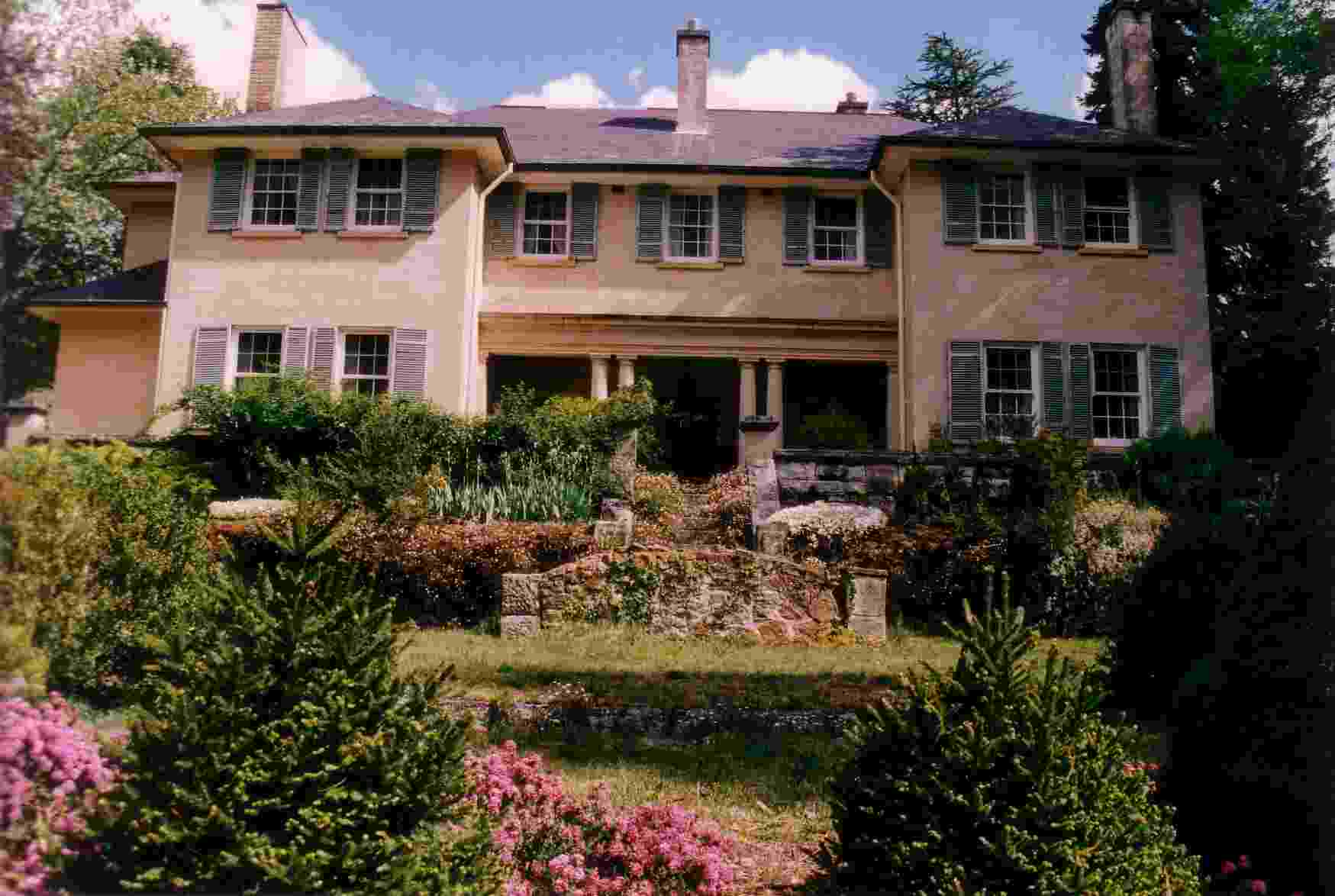
Wynstay: Hare's Xanadu?
Wynstay may have lent some features to Xanadu, Norbert Hare's grand house on the edge of Sydney in Riders in the Chariot. In that novel the Hares (like the Wynnes) are Sydney merchants not graziers like their cousins the Urquhart Smiths (and the Whites).
Mr Hare builds his Xanadu in stone, complete with park gates: "golden, golden, in a frill or two of iron lace, beneath the dove-grey thatching of imported slates, its stables and bachelor quarters trailing out behind .... [He acquired] an exquisite setting for his humours: the park of exotic, deciduous trees, the rose garden which his senses craved, pasture for the pedigree Jersey cows which would fill his silver jugs with cream, and stables for the horses which he drove himself with virtuosity - always grey, always four-in-hand" (Riders in the Chariot). Mr Hare meets his death in the cistern at Xanadu, a covered well, like the one at the back of the stables at Wynstay.

The configuration of the Post Office, working farms and great house in The Tree of Man and in Riders in the Chariot suggests the layout of Mt Wilson more clearly than the western suburbs of Sydney where they are set. Mt Wilson also gave White his most intimate experience of bushland.
White's play Night on Bald Mountain is set in a place like Mt Wilson where an academic keeps his alcoholic wife in a grand old house. The philosophical discussions in the house are contrasted with the down-to-earth attitude of Miss Quodling, the local goatkeeper (White's mother had brought a goat to Withycombe).
The small society at Mt Wilson with its enclave of rich families and their servants must have sharpened White's sense of class difference. Unlike most other Australians of his generation, he spent his childhood in the society of wealthy people but developed his closest attachments to servants. At Mt Wilson he was often alone with servants and working people. This awareness of class gives novels, such as The Vivisector, The Eye of the Storm, A Fringe of Leaves, and The Twyborn Affair a perspective on Australian life that reaches back to nineteenth-century British aspirations to recreate genteel county society in the new country.
Acknowledgements
- Details
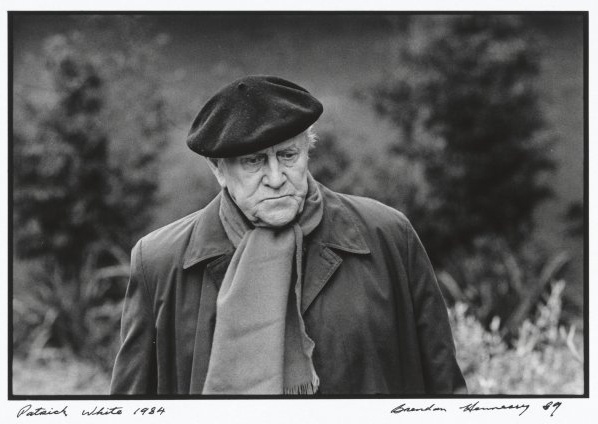
Portrait of Patrick White in 1984 by Brendan Hennessey.
- Bernadette Brennan and Susan Lever, University of Sydney and Association for the Study of Australian Literature, for their professional literary expertise and advice.
- Filtered Media for the filming and editing of the DVD that accompanies this exhibition.
- Bernadette Brennan, Huw Evans, Rachael Kohn, Susan Lever, David Marr, Libby Raines, Mary Reynolds and Peter Valder for their involvement in the interviews.
- Barbara and Merrick Howes, and Joe and Diana Landsberg, for their support and enthusiasm.
- Barbara Mobbs, Patrick White's literary executor.
Exhibition created and written by:
- Des Barrett
- Fiona Carruthers
- Peter Dempsey
- Tim Gow
- Alison Halliday
- Susan Lever
- Mary Reynolds
Graphic design by Jess Delbridge
Printing of charts made possible and kindly undertaken by Conybeare Morrison International Pty Ltd
The Red Admiral - Patrick White at Mt Wilson exhibition is supported through generous funding from the Australian Government's Your Community Heritage Program.
Copyright Mt Wilson and Mt Irvine Historical Society Inc, 2012.
Except as permitted under the Copyright Act, no part of this material may be reproduced without permission of the Society.



